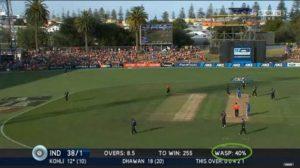A Microscopic Look into WASP
View : 411
3 Min Read


A Microscopic Look into WASP: Lately, an interesting factor in Cricket has evolved and we have been witnessing it since the past one year or so. It is WASP, abbreviated as Winning And Score Predictor. To define it in brief, WASP is a tool to estimate the game situations in ODIs and in T20Is and to predict the game based on some complex mathematical calculations.
DEVELOPMENT:
The concept of WASP was coined by the PhD graduate from the University of Canterbury, Dr. Scott Brooker and his supervisor, Dr. Seamus Hogan. These two explained the functionality of the approach. They invented this as a part of their research work, titled as “A Method of Inferring Batting Conditions in ODI Cricket from Historical Data.”
WASP:
Basically, WASP stands for 2 purposes, one for the team batting first and the other for the team batting second respectively.
- For the team batting first, WASP predicts the likely score to be made by the team in the first innings by considering several parameters like pitch conditions, team’s record while batting first, team’s record while batting first against the particular opposition, batsmen on the crease and several other factors to make the prediction apt to a good extent.
- For the team batting second, WASP makes a prediction of the successful chase of the target as a percentage. Here as well, several factors like pitch, ground size, batting strengths, bowling strengths, history between the two teams and other detailed factors are taken into consideration. For instance, if a situation arises in an ODI that India are to chase 100 runs in the last 12 overs against a not-so strong opposition like Zimbabwe, the WASP will show the percentage of winning in favour of India even when the required rate is theoretically very high for winning.
WASP Features:
- It is not like any simple methods as run rate predictors which basically does nothing but to predict the score of a team in the innings if the team goes with some run rate.
- It takes into account all the records since 2006 for ODIs and sometime earlier for T20s. Now it is not known as to why 2006 is chosen as the benchmark.
- It takes into account of several factors including pitch conditions, size of the ground, possession of quality batsmen, bowling strength of the team, team’s history in similar kind of situations, team’s record against the opposition and several other minute factors to make the prediction, more accurate.
- Viewers can get to know about foreseen situations based on it and is purely mathematical with a blend of practical situations.
WASP INTRODUCTION:
WASP was introduced for the first time back in November, 2012 by Sky Sports New Zealand during Auckland’s HRV cup T20 game against Wellington.
WASP WORKING:
Let V(b,w) be the additional runs added to the team’s score from the present situation of the game.
b- stands for the number of balls being bowled so far and
w- stands for the number of wickets fallen so far.
Let r(b,w) be the expected runs on the next ball.
Let p(b,w) be the expected probability of a wicket falling in the next ball.
The Formula can be written as :
V(b,w) =r(b,w) +p(b,w) V(b+1,w+1) +(1-p(b,w)))V(b+1,w)
Since V(b*,w)=0 where b* equals the maximum number of legitimate deliveries allowed in the innings (300 in a 50 over game), we can solve the model backwards.
This means that the estimates for V(b,w) in rare situations depends only slightly on the estimated runs and probability of a wicket on that ball, and mostly on the values ofV(b + 1,w) and V(b + 1,w + 1), which will be mostly determined by thick data points.
The same algorithm is used for the second innings.
DRAWBACKS:
- This method does not take into account if a player is retired hurt.
- This method is not adequate for rain interrupted matches.
- If a team happens to surpass the predicted score, the method fails.
- Cricket, being full of uncertainties, nothing can measure a batsman’s form and ability to score big. Same is applicable for a bowler.
- Likewise, England never scored over 400 runs in ODI history prior to their first ODI against New Zealand. WASP thus failed to estimate such score.
Download Our App